Architectural Wonders of DIFC: A Deep Dive
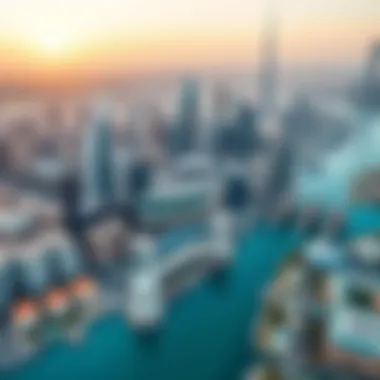
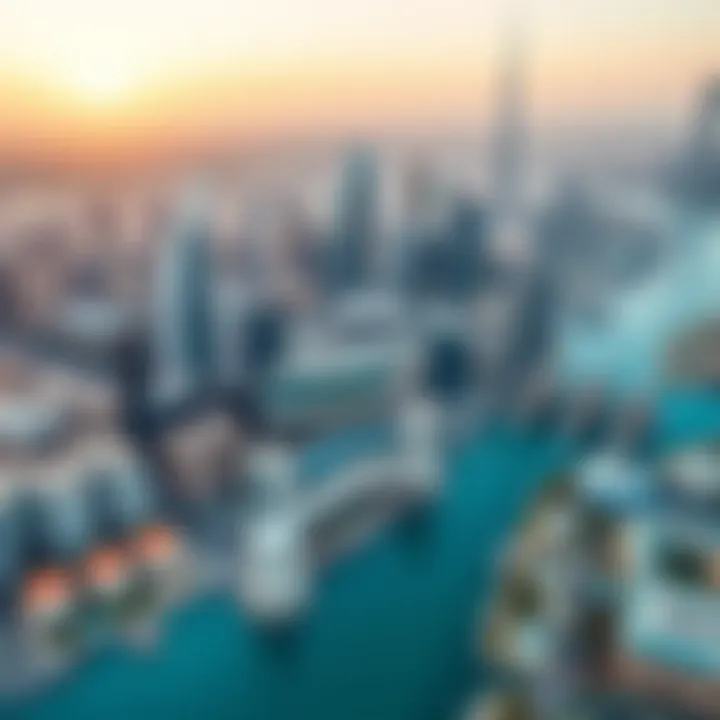
Intro
The Dubai International Financial Centre (DIFC) stands as a beacon of modernity and innovation in the bustling landscape of Dubai. It’s not merely a business hub, but rather a thoughtfully architected environment that merges functionality with cutting-edge design. For homeowners, visitors, urban planners, and architects alike, understanding the architectural landscape of DIFC provides insights not just into the buildings themselves, but into the broader narrative of urban development in a city renowned for its soaring skyline and economic vitality.
DIFC's architecture tells a story of ambition, with each structure contributing to an evolving narrative that blends style and substance. This article dives into essential aspects of these buildings, focusing on neighborhood features such as unique landscaping and architectural styles, alongside the community life that pulses within the center.
By examining the thoughtful design principles that underpin DIFC’s skyline, the historical context that shaped its inception, and its significant role in the global financial ecosystem, one gains an appreciation for how commerce and creativity can coexist harmoniously. As we embark on this exploration, it is clear that DIFC is not just a location but a cultural and commercial landmark that resonates with past, present, and even future architectural trends.
Neighborhood Features
Landscaping Highlights
The streets of DIFC are adorned with more than just impressive buildings. The landscaping around these structures plays a crucial role in shaping the ambiance of the area, providing spaces that are both functional and visually appealing. Thoughtfully placed greenery, like palm trees and flowering plants, tempers the otherwise stark urban environment. Pathways are lined with vibrant shrubs that soften the concrete, creating a pleasant juxtaposition.
Moreover, the integration of art installations within green spaces encourages interaction and reflection. These artistic elements enhance the character of the neighborhood, making it a haven not only for business professionals but also for art enthusiasts and casual strollers alike. Importantly, the landscaping serves to reduce heat and improve air quality, contributing to a more sustainable urban framework.
Here are some key landscaping elements found in DIFC:
- Water features: Reflecting pools and fountains establish a serene atmosphere.
- Green roofs: Several buildings employ this technique, providing insulation and promoting biodiversity.
- Community gardens: Spaces for social interaction and local horticulture promote community wellness.
Architectural Styles
DIFC's architectural tapestry is woven from a variety of styles that reflect both local heritage and international influences. Each building presents a unique vision of what modern architecture can achieve in a city that embraces the avant-garde. The designs are not just aesthetically pleasing; they embody the principles of sustainability and innovation.
One may notice the prevalence of glass and steel façades, which shimmer under the Dubai sun, representing transparency in business and creativity. Iconic structures like the Burj Daman display a mix of contemporary lines with traditional Middle Eastern elements, creating a visually striking silhouette against the skyline. Another notable example is the Dubai Multi Commodities Centre (DMCC) building, known for its use of geometric forms that create a sense of dynamism.
Below are some prominent architectural styles evident throughout DIFC:
- Postmodernism: Utilizing eclectic designs that challenge traditional forms.
- Islamic Revival: Incorporating motifs and patterns inspired by Islamic art.
- Minimalism: Focus on simplicity and clean lines that enhance functionality.
"The architectural journey within DIFC illustrates how design can elevate urban experiences, inviting exploration and fostering community."
In summary, the architectural landscape of DIFC is not merely a backdrop for financial transactions, but a rich blend of art and utility, where each element serves to enhance the overall experience of this urban oasis.
Preamble to DIFC
The Dubai International Financial Centre (DIFC) stands as a beacon of architectural innovation and economic vitality in an ever-evolving global landscape. Its strategic position as a financial hub is not merely a result of geographical advantages; it is intricately tied to the architectural marvels that comprise its skyline. This section dives into the essence of what DIFC represents — a melding of cutting-edge design with functional necessity, making it pivotal in contemporary discussions about urban planning and economic growth.
Overview of the Dubai International Financial Centre
Established in 2004, DIFC has become a cornerstone of Dubai's aspirations to position itself as a global financial powerhouse. Encompassing 110 acres, the Centre is more than just a location; it is a carefully curated ecosystem crafted to foster commerce and investment. The architecture here reflects a unique blend of local culture with international trends, showcasing structures that are at once functional and aesthetically pleasing. Prominent buildings like the Burj Daman and the striking Gate Village are pivotal in formulating a visual narrative that speaks of both progress and tradition.
At its core, DIFC includes office spaces, retail outlets, and residential units organized around a beautifully designed leisure district filled with dining options and cultural hotspots. This thoughtfully orchestrated layout encourages interaction among diverse sectors, engaging financial institutions, legal firms, and art galleries alike, transforming the Centre into a meeting point for ideas and innovation.
Importance in Global Finance
DIFC is not just an architectural feat but a significant player in the global finance arena. It serves as a bridge for capital flows between the East and West, attracting major financial firms such as DBS Bank, Morgan Stanley, and HSBC. Within its jurisdiction, DIFC operates under a regulatory framework that mirrors global standards while catering to local needs, making it a preferred venue for both multinational corporations and startups.
The economic impact of DIFC cannot be overstated. It is estimated that DIFC contributes roughly 4.3% to Dubai's GDP, a figure that underscores its importance as an employment hub and as a catalyst for regional economic development. The legal and operational structures established here have enabled firms to operate with ease, encouraging foreign investment and strengthening Dubai's status as a financial center.
The architectural vitality of DIFC is matched only by its financial acumen, creating an environment where commerce flourishes amid stunning design.
In summary, the introduction to DIFC not only sets the stage for understanding its architectural significance but also highlights its critical role in shaping Dubai's global financial identity. As one delves deeper into the specifics of the buildings that define this district, the harmonious interplay of design and function becomes evident.
Architectural Significance
The architectural significance of the Dubai International Financial Centre (DIFC) cannot be overstated. It represents a striking fusion of functionality and avant-garde design that is essential to the identity of this financial hub. Within this section, we will delve into how the architecture of DIFC serves not only as physical infrastructure but also as a crucial element in shaping the business environment and aesthetic experience in Dubai. Each building tells its own story, showcases a unique design philosophy, and contributes to an overarching vision that transcends mere utility.
Design Philosophy Behind DIFC Structures
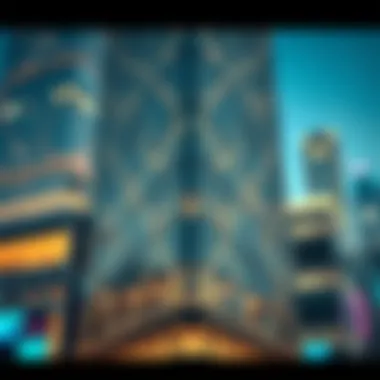
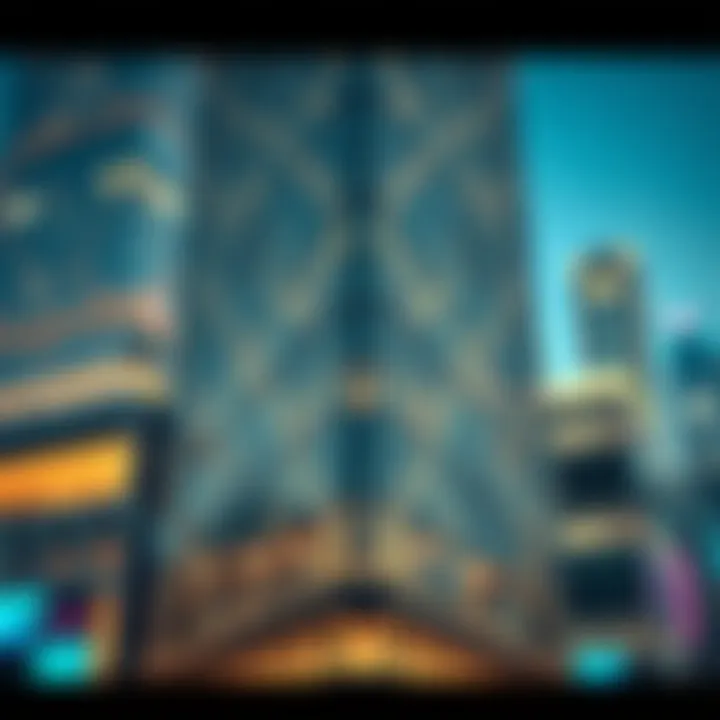
The design philosophy embraced by the structures in DIFC is a harmonious blend of modernism and cultural reflection. Architects have incorporated sleek lines, futuristic materials, and bold geometries, establishing a skyline that speaks to innovation and progress. Buildings feature expansive glass façades that invite natural light while mirroring the skyline, creating an engaging interaction with the surroundings.
Moreover, sustainability is a recurring theme in design principles adopted within DIFC. Many buildings adhere to green building standards, prioritizing energy efficiency and ecological considerations in their construction. As a result, these structures do more than house financial transactions; they embody a commitment to an environmentally conscious future, setting a precedent in smart building practices.
Iconic Buildings of DIFC
Burj Daman
Burj Daman stands as a notable highlight within the DIFC area, differentiating itself with its unique architectural approach. Characterized by its triple-faceted form, the building contributes to the skyline with a distinctive silhouette. Its design focuses on maximizing space while providing an aesthetic balance that captivates both visitors and locals alike.
Burj Daman boasts cutting-edge amenities that cater to the modern workforce, making it a preferred location for businesses seeking premium workspace solutions. A standout quality of the building is its luxurious penthouses, which offer breathtaking views of the cityscape and the wider financial district, serving as an enticing feature for high-profile tenants. One might argue that the cost of luxury, however, raises questions regarding accessibility for smaller businesses.
Gate Village
Gate Village is a hallmark of architectural ingenuity within DIFC, often celebrated for its ambitious design that revolves around creating a dynamic space for businesses and leisure. The village comprises various low-rise structures that house art galleries, boutiques, and al fresco dining experiences, fostering a communal atmosphere. The buildings integrate art and culture seamlessly into the working environment, distinguishing Gate Village from its towering counterparts.
One of its essential traits is the interconnectedness of the spaces, allowing pedestrians to navigate comfortably. This unique composition not only promotes interaction among visitors but also enhances the overall aesthetic experience. However, maintaining such an idyllic balance raises challenges in terms of urban flow and accessibility.
Arif Habib Building
The Arif Habib Building adds to the architectural diversity of DIFC through its striking design and functional spaces. Often recognized for its vertical gardens and innovative use of space, this structure embodies a commitment to sustainability while offering unparalleled office environments. The incorporation of greenery manifests in multiple levels, contributing to improved air quality, a feature that aligns well with the increasing focus on health and well-being in urban architecture.
Despite its numerous positive attributes, the building's imposing height may induce feeling of isolation for some individuals, particularly those working in lower floors. Nevertheless, Arif Habib Building serves a critical role in showcasing how architecture can embrace nature without compromising productivity.
In summary, each of these buildings not only stands as a symbol of progressive architecture but also reflects the evolving identity of the DIFC as a key player in the global financial landscape.
Landscaping Elements
The significance of landscaping elements within the Dubai International Financial Centre cannot be overstated. As an axis of commerce and finance, DIFC showcases not only striking architectural feats but also thoughtfully landscaped areas that contribute to the overall experience of the space. The integration of both natural and artificial elements creates a harmonious environment that enhances the aesthetic appeal while also serving functional and environmental purposes.
Integration of Green Spaces
In a bustling financial hub like DIFC, green spaces offer a much-needed respite from the urban rush. The concepts of biophilic design, which emphasize the connection between people and nature, are woven into the very fabric of the area.
Key benefits of integrating green spaces include:
- Air Quality Improvement: Plants play a vital role in filtering pollutants, improving air quality for both the workforce and visitors.
- Psychological Relief: Proximity to nature reduces stress, fosters creativity, and encourages relaxation during breaks from the workday.
- Microclimate Regulation: Strategically placed trees and vegetation can cool down the immediate environment, providing shade and reducing the urban heat island effect.
Several parks and landscaped areas, like the popular DIFC Park, have been designed with these facets in mind. With palm trees, colorful flower beds, and seating areas, they create an inviting atmosphere. People can congregate, plan meetings outdoors, or simply unwind in the calming green space. This blend is not just beneficial but essential—attitudes towards urban living increasingly favor spaces where nature and urbanity coexist.
Art Installations and Urban Design
Art in urban design has the power to elevate public spaces, making them lively and engaging. DIFC is rich in artistic expression, featuring installations that are not merely decorative but also narratives that reflect Dubai's cultural ethos.
Art installations can be classified into several types, including:
- Sculptures: From striking metal forms to intricate stone carvings, sculptures dot the landscape and serve as focal points that prompt conversation.
- Murals: These larger-than-life artworks transform plain walls into visual stories, often illustrating themes that resonate with local history or aspirations.
- Interactive Pieces: Engaging art invites people to participate rather than just observe—think of kinetic sculptures or installations that respond to human presence.
"Art bridges connections within the community, fostering interaction between businesses and individuals."
Prominent sculptures in DIFC, like The Custodian by Khaled Al Saai, showcase local talent and serve as landmarks within the urban fabric, guiding visitors through the financial center. Such installations not only beautify the environment but also instil a sense of pride in the local community and attract tourism.
Emerging Trends in Architecture
In the fast-paced world of architecture, trends evolve as swiftly as the skyline of a city. The Dubai International Financial Centre (DIFC) stands at the forefront of these shifts, serving not only as a hub for finance but also as a canvas for innovative architectural practices. Addressing emerging trends in architecture is crucial. It sheds light on how DIFC buildings adapt to modern demands while also setting benchmarks in sustainability and technology. These tendencies reflect the aspirations of a global community, intertwining functionality with aesthetics.
Sustainability in DIFC Developments
Sustainability has emerged as more than just a buzzword; in the DIFC, it is a guiding principle that shapes the architectural landscape. Recent constructions increasingly integrate renewable energy sources and use materials that minimize environmental impact. For instance, many buildings have been designed to optimize natural light and reduce energy consumption.
- Green Roofs: Structures like the Burj Daman are now fitted with green roofs, which not only improve air quality but also regulate building temperatures, contributing to energy efficiency.
- Rainwater Harvesting: Some developments incorporate systems to capture and utilize rainwater, minimizing water wastage in a region that often grapples with scarcity.
- LEED Certification: Many DIFC buildings aim for LEED (Leadership in Energy and Environmental Design) certification. This international standard encourages the adoption of sustainable building practices.
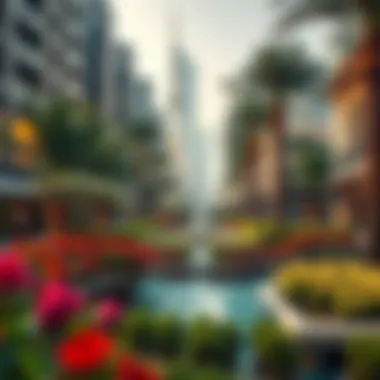
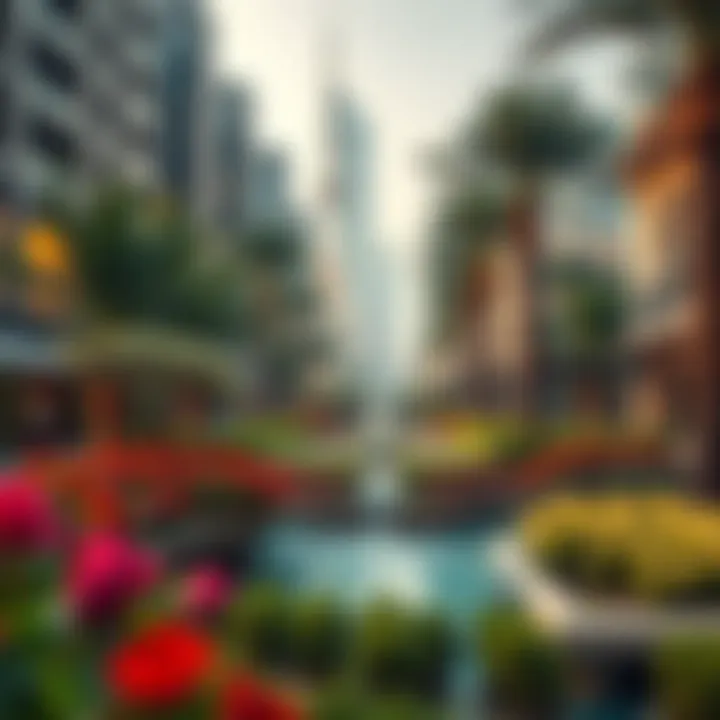
By prioritizing eco-friendly designs, DIFC aims to show that economic growth and environmental responsibility can go hand in hand. It is a declaration to the world that they are committed to a greener future.
Smart Building Technologies
The second trend gaining ground in DIFC is the incorporation of smart building technologies. These advancements drastically enhance how occupants interact with their spaces, creating a more efficient and safe environment.
DIFC structures like the Arif Habib Building utilize various smart technologies that include:
- Automation Systems: These systems control heating, ventilation, and air conditioning (HVAC) based on occupancy levels. This not only maximizes comfort but significantly cuts down energy costs.
- Integrated Security Features: Advanced security systems employing AI and facial recognition ensure that safety is a priority.
- Data Analytics: Buildings are now equipped with sensors that analyze usage patterns, providing valuable insights into optimizing operational efficiency.
To sum it up, DIFC is molding its grid into a technologically advanced ecosystem. This transformation addresses the modern needs of inhabitants while also bolstering the district's competitive edge in global markets. As these trends unfurl, they signal a shift not just in architectural practices but in the very fabric of urban living.
Economic Impact of DIFC Buildings
The Dubai International Financial Centre (DIFC) holds a pivotal place in not only the financial world but also in shaping the architectural and economic landscape of Dubai. The buildings within the DIFC are not mere structures; they act as catalysts for economic growth and development. This segment aims to elucidate the economic significance of these edifices, presenting a nuanced understanding of how they attract investments and influence the local real estate market.
Role in Attracting Investments
The architecture of the DIFC itself speaks volumes about the district’s role in attracting investments. Each individual building stands as a beacon of modernity and professionalism, enticing foreign companies and international investors. The key factors influencing this attraction include:
- Prestige and Authority: Walking through DIFC’s streets, one can’t help but feel the air of sophistication. Landmarks like the Burj Daman tower exude prominence that draws businesses wanting to be associated with such an esteemed location.
- Business Ecosystem: The diverse range of firms based in DIFC—from finance to technology—creates a dynamic environment. Knowing that one can engage with other leading companies boosts investor confidence. It’s like being at a well-stocked marketplace: when everything now just comes together, it’s hard to resist.
- Incentives and Regulations: DIFC has established favorable tax regulations, along with business-friendly policies, that are appealingly inviting to foreign entities. It’s a no-brainer for companies looking to maximize profits. As a result, foreign direct investment (FDI) flows more naturally than water down a hill.
In short, the striking buildings, combined with the robust ecosystem and enabling policies, play a crucial role in securing investments that feed the engine of Dubai’s economy.
Impact on the Local Real Estate Market
The DIFC isn’t isolated from the impact it has on the local real estate market. Quite the opposite, really; it acts like a ripple effect that extends into the broader Dubai real estate landscape. Some primary impacts include:
- Property Value Appreciation: Properties located within or nearby the DIFC tend to see increased value over time. The demand is high because businesses want proximity to financial institutions, which leads to escalating prices. This phenomenon isn’t simply a trend; it’s a robust pattern formed over years of economic activity.
- Development of Surrounding Areas: With the DIFC drawing businesses, developers have begun to construct new residential projects to meet the needs of the influx of professionals. Areas around DIFC are sprouting up with modern living spaces, which in turn promotes local commerce. It’s a beneficial cycle of growth that fosters community expansion, too.
- Rental Market Boon: There’s a significant rise in demand for office spaces and residential units near the DIFC. Businesses seek flexible office arrangements, while expatriates look for convenient dwellings. As this demand grows, rental prices inevitably follow suit.
"In a strongly connected urban financial ecosystem such as DIFC, the architectural landscape directly influences economic dynamics."
For further details about the economic implications of DIFC developments, visit Wikipedia and Britannica.
When assessing the economic significance of DIFC buildings, it’s crucial to recognize that their ramifications extend well beyond their immediate vicinity, acting as a linchpin in Dubai’s developing narrative.
Cultural Perspectives
Cultural perspectives in the realm of architecture reveal much about the community's identity and values. In DIFC, this rich tapestry is woven intricately, reflecting a blend of global influences while maintaining local flavor. The architectural designs do not merely serve their functional purpose; they engage and resonate with the inhabitants and visitors alike. This section will delve into two pivotal aspects: the fusion of tradition and modernity, and the host of cultural events that foster community engagement.
The Fusion of Tradition and Modernity
The Dubai International Financial Centre stands as a testament to the melding of age-old customs with the cutting-edge designs of contemporary architecture. In the heart of a booming business district, you can see structures that echo the region’s past and reflect the dynamic nature of modern innovation.
- Cultural Identity: For instance, they incorporate aesthetic elements reminiscent of traditional Islamic architecture, like intricate geometric patterns and opulent materials. Buildings such as the Burj Daman project a contemporary look while also integrating design motifs that pay homage to the rich heritage of the region. This isn’t just about appearances; it represents a nostalgic connection to the past while boldly stepping forward.
- Visual Narratives: Moreover, the use of local craftsmanship in facade details creates a dialogue between the old and new. When one looks at the structures, they don’t only see glass and steel; they observe a narrative that speaks to a community evolving within a globalized frame. The interplay of shadows and light through these designs can invoke a sense of wonder, inviting onlookers to pause and reflect.
"Architecture is the frozen music of history." – Friedrich von Schelling
Cultural Events and Community Engagement
DIFC is not just a space for financial transactions; it is a vibrant community hub. Regular cultural events are pivotal in driving social engagement and enhancing the sense of belonging among residents and visitors.
- Art Exhibitions and Festivals: Throughout the year, art showcases grace the streets of DIFC, with local and international artists displaying their works. Events such as Art Dubai highlight the intersection of art and commerce, attracting art enthusiasts and creating a bustling atmosphere.
- Workshops and Panel Discussions: The community gears up for various workshops that explore cultural dialogues. These gatherings foster collaboration and understanding among diverse groups, contributing to a stronger community fabric.
- Public Installations: The open spaces in DIFC often serve as backdrops for public art installations, enriching the environment and offering spaces for reflection and social interaction. This engagement with art not only beautifies but also prompts discussions around cultural relevance in today’s world.
In essence, the architectural landscape of DIFC isn't merely about economic success but resonates with cultural richness and community ties. As such, cultural perspectives are integral in enhancing both the aesthetic experiences and the overall community dynamics within the DIFC precinct.
Challenges in Development
The intricate fabric of the Dubai International Financial Centre (DIFC) buildings is not merely woven with bricks and concrete but also through the challenges faced during their development. Understanding these challenges is crucial for grasping the dynamic interplay between architecture, urban design, and economic sustainability.
Regulatory and Compliance Issues
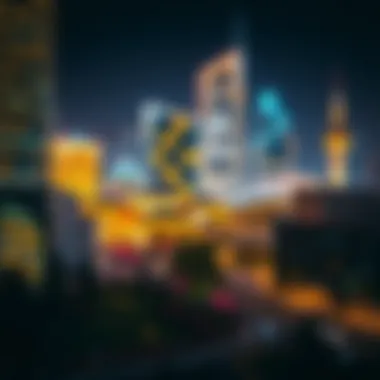
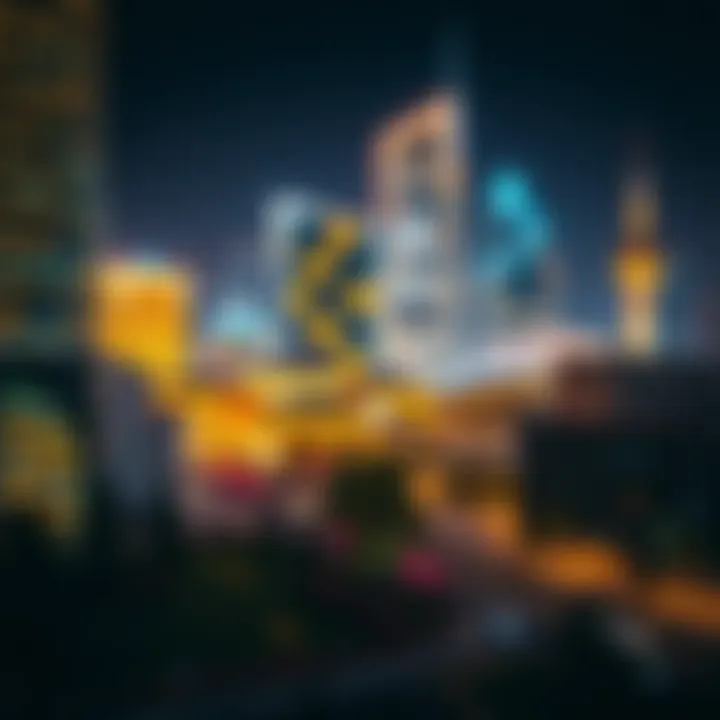
Creating a structure in the DIFC is no walk in the park. Developers have to navigate a complex web of regulatory and compliance frameworks. These regulations are intended to ensure safety, environmental integrity, and economic stability. Failure to comply can result in delays and financial penalties, not to mention the risk of damage to a company’s reputation.
One major aspect of this regulatory landscape is the Dubai Development Authority (DDA), which mandates strict adherence to the architectural vision of Dubai. Developers must submit their plans for rigorous review, ensuring that each building aligns with the aesthetics and functionalities of the DIFC district. Moreover, sustainability codes have become more stringent, pushing projects towards greener practices, which can add layers of complexity yet is vital in today’s climate-conscious era.
- Key factors to consider include:
- Zoning Laws: Identifying use cases for buildings, which determines design and functionality.
- Environmental Permits: Ensuring that developments don’t negatively impact the ecological balance.
- Safety Regulations: Attending to the structural reliability as per international standards.
The compliance dance can feel overwhelming but is essential for a thriving urban environment that doesn’t just grow, but flourishes responsibly.
Economic Fluctuations and Their Effects
Economic fluctuations exert a unique strain on development strategies. In a fast-paced financial hub like DIFC, changes in the economic landscape can ripple through various sectors, affecting everything from project timing to financing options.
As the economy oscillates between prosperity and downturns, the funding for new projects often becomes a sensitive issue. Investors may hesitate to back a new venture during uncertain times, leading to stalled or abandoned developments. This can create ghost buildings, structures that stand incomplete, casting shadows over the ambitious skyline that DIFC represents.
In addition, tenant demand fluctuates. When market conditions dip, businesses might downsize or even relocate, leaving large commercial spaces vacant. This creates a dilemma for property owners: whether to lower rents to attract tenants or hold out for better economic times, which can lead to increased vacancy rates. This situation often forces developers to reassess their strategies continuously.
- Some challenges include:
- Cash Flow Issues: Construction projects can be costly and may face interruptions in funding.
- Market Saturation: Too many similar buildings can dilute demand, affecting profitability.
- Investment Climate: Economic uncertainties can deter foreign investments, pivotal to projects in DIFC.
"In the world of finance and architecture, stability is often just a market cycle away. Adjusting to the ebb and flow of economic conditions is as much a challenge as constructing the buildings themselves."
The constant shifting of economic tides is something that developers must learn to ride like a wave; adept navigation can lead to successful projects, while miscalculations might leave a trail of unfinished visions. Understanding these challenges offers a clearer perspective on the ongoing growth and evolution of DIFC, further solidifying its role as a vital part of Dubai's architectural identity.
Future of DIFC Buildings
As the Dubai International Financial Centre continues to solidify its position as a leading financial hub, the future of its buildings reflects much of the evolving trends in architecture, urban planning, and sustainability. This discussion is crucial not just for those invested in real estate but for architects, urban planners, and even residents who experience the impact of these developments daily. The importance lies in understanding how projected developments and contemporary design philosophies can shape a city’s ethos.
Projected Developments and Expansions
With Dubai’s vision set on becoming a global center for finance and trade, several projected developments are in the pipeline for the DIFC. These plans encompass innovative architectural designs that blend functionality with sustainability, effectively responding to both economic demands and environmental considerations.
- Horizontal Expansion: There is a focus on extending the current boundaries of the DIFC. New projects aim to create a seamless connection between existing buildings and new developments, allowing for easier accessibility and integration of services. This expansion could foster a lively atmosphere that encourages business interactions and cultural exchanges.
- Mixed-Use Developments: Unlike traditional financial districts, the future DIFC plans to incorporate more mixed-use developments. These buildings will combine residential spaces, office premises, and recreational facilities within a single complex, promoting a vibrant community feel. The blend of working and living spaces is significant; studies show that such designs boost productivity and improve residents' quality of life.
- Focus on Sustainability: As environmental consciousness grows, impending developments will also prioritize green construction practices. Architects are expected to utilize sustainable materials, incorporate green roofs, and design buildings that maximize energy efficiency. This commitment not only addresses environmental concerns but also enhances the appeal of DIFC as a modern urban locus.
Envisioning the Next Decade
Looking ahead, the next decade at DIFC signals a transformational journey influenced heavily by advancements in technology and the evolving needs of society. The essence of this vision encompasses several key elements:
- Integration of Smart Technologies: Future buildings will likely feature advanced technology systems that facilitate smart working environments. Automation systems for climate control and lighting will enhance energy efficiency, leading to reduced operational costs for businesses.
- Cultural Destinations: As the DIFC progresses, expect an infusion of cultural facilities such as galleries and performance spaces. This move would serve not just the financial services community but also a wider audience, contributing to the city’s cultural fabric. Reimagining buildings as places for interaction and innovation will create a dynamic atmosphere.
- Resilience against Economic Fluctuations: The architectural landscape will also need to adapt to unpredictable market conditions. Flexibility in design and purpose will allow buildings to pivot as market demands shift. The idea here is to ensure that structures are not only visually striking but also pragmatically viable in changing economic landscapes.
In the end, the future of DIFC buildings rests on a thoughtful combination of visionary design and practical application. As they rise and evolve, they will encapsulate the spirit of their time while setting the stage for the next generation of architecture in Dubai.
"Urban development is not just about creating structures; it’s about weaving together lives and experiences to shape communities for the future."
The journey into this future is sure to be exciting and fraught with opportunities that could pave the way for an even more resplendent Dubai. The architectural landscape of DIFC is primed to reflect the ambitions and aspirations of its stakeholders, connecting the past’s resilience with future innovation.
Closure
The architectural landscape of the Dubai International Financial Centre (DIFC) plays a pivotal role in shaping not only the skyline of Dubai but also its economic and cultural narratives. By examining the intricacies of the various buildings, one can appreciate the synergy between functionality and aesthetics that defines this area. The culmination of innovative design, sustainable practices, and community engagement in the DIFC sets a benchmark for future urban developments globally.
Summary of Insights
In summary, DIFC serves as a microcosm of how urban design can facilitate commercial success while enhancing the livability of a space. The distinct architectural styles found across its buildings showcase diverse influences—from modern glass facades to elements drawn from Arab culture.
Key points highlighted in this exploration include:
- Design Versatility: The blend of modernism with traditional motifs creates visually compelling structures.
- Economic Hub: Each building contributes to the financial vibrancy of UAE, reinforcing DIFC’s status as a significant player in global finance.
- Sustainability Focus: Commitments to eco-friendly designs reflect a growing awareness of environmental responsibilities in urban settings.
- Cultural Integration: Art installations and public spaces invite community interactions, fostering a sense of belonging within a bustling business district.
Final Thoughts on DIFC's Role in Urban Development
As we look to the future, it is clear that DIFC stands not just as a financial centre but also as a testament to what urban development can achieve when creativity and practicality intersect. The centre has become a hallmark of Dubai's ambition, where each building isn't merely a structure but a statement of progress and innovation.
The ongoing projects and initiatives suggest that DIFC will continue to evolve, adapting to the demands of a changing global economy while remaining rooted in its cultural heritage. In a world where cities are often seen as mere backdrops to human activity, DIFC shines as a vibrant community space, enriching both the lives of its occupants and the wider city of Dubai.
With its focus on sustainability, community engagement, and architectural excellence, the DIFC sets an inspiring model for urban planners, architects, and city dwellers alike. This district not only houses financial institutions but also nurtures art, culture, and innovation, making it a vital part of Dubai’s ongoing narrative.















